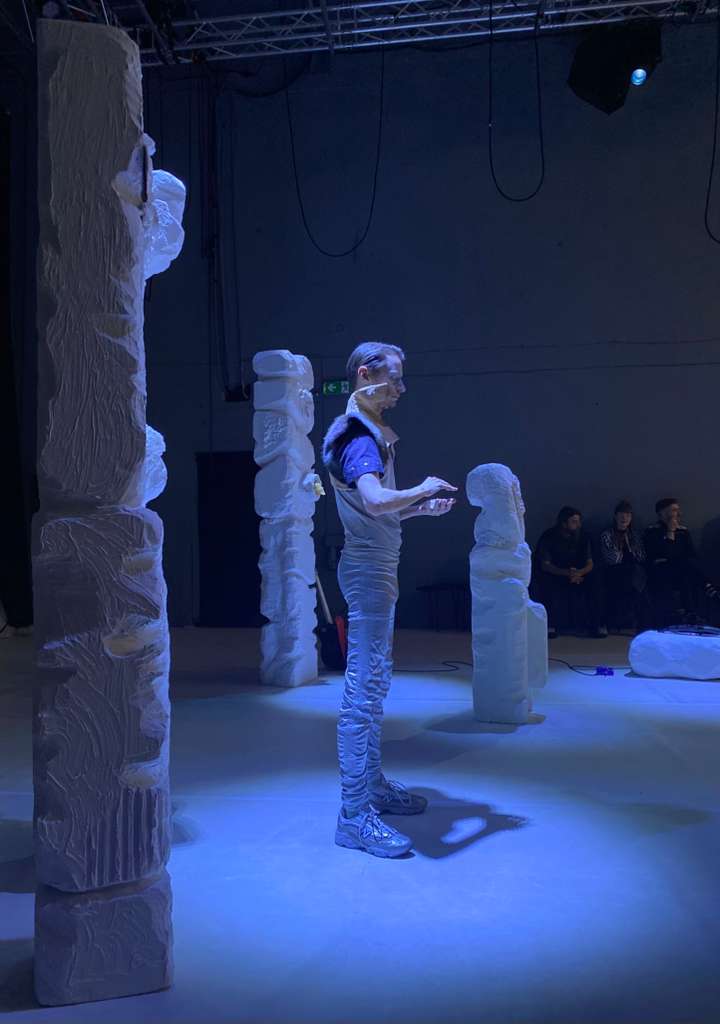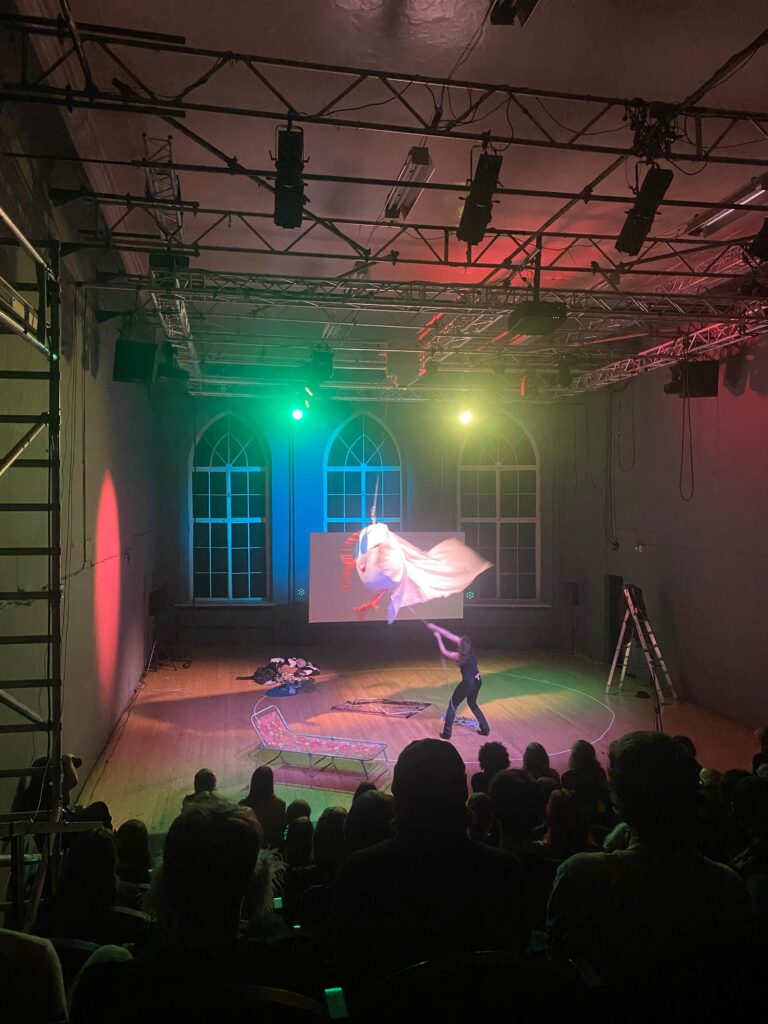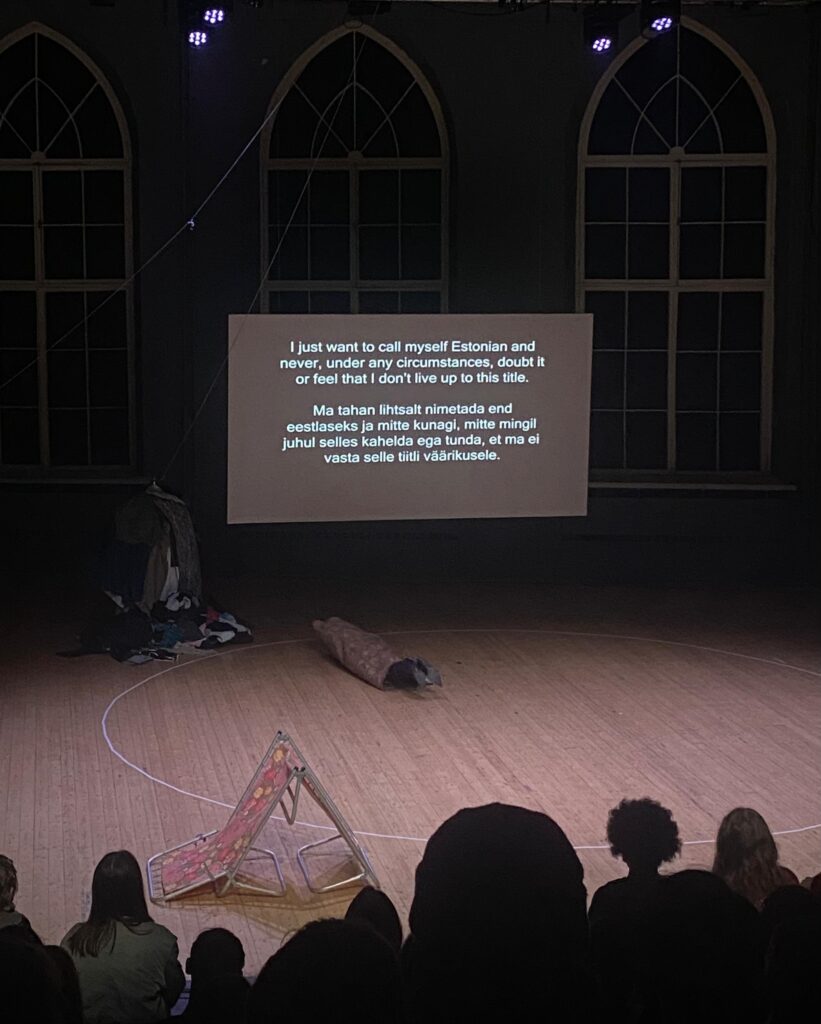Five minutes before the show begins, Kanuti Guild Hall is packed solid. From wall to wall, audience members squeeze past one another, balancing drinks in hand, or lounge about with friends on plush green sofas and armchairs. An announcer steps up near the bar, projecting his voice over the crowd. Switching between English and Estonian, he welcomes everyone in and explains the format of tonight’s show. For SAAL3’s fourth iteration, he promises a night of once-in-a-lifetime performances—none of the three shows will likely ever be repeated. With a tangible sense of anticipation, the spectators are ushered into the main performance hall.
Norman Orro is on first with his performance, “Vox Aevum.” While we file in, I hear audience members chime in about being excited for Orro’s work—he seems to be well-known by the crowd, many of whom (as I will later learn) have come just for him. As everyone takes their seats, either in the stands or bordering the open stage, Orro stands in the center of the room, a soft blue glow enveloping him. His clothes are both futuristic and ancient at the same time, a mix of animal skins and silver spandex. Five pillars of differing heights and designs rise up around him, and he moves his hands slowly, turning his head gently back and forth to watch the crowd.

As a hush settles over the room, Orro begins, taking us on a journey of sound. He uses videos projected in the background throughout the performance, playing an array of instruments to go along with each one. Images of a chirping bird, swirling faces and stone edifices, revelers at Stonehenge and a tribal musician, all take their turn on the screen. Orro whistles along with the bird, uses an ornate tongue drum during a psychedelic swirl of images, plays an electric saxophone to accompany the indigenous instrumentalist, and takes up an electric guitar to the Stonehenge solstice celebration. The tone and the tune shift throughout, with onlookers later saying how intrigued they felt by the flow of it, how moved. As Orro plays his guitar, a fog machine exhales a wall of smoke into the room. The audience is enveloped entirely, forcing the focus to just the musical notes drifting throughout the air, as the first performance comes to an end.
During the pause, I speak with spectators, who all give glowing reviews. One mentions that he appreciates the “stage friendly context,” enjoying that the seating around the center of the room gave such an intimate view of the performance. Being so close added to the emotion of the act too—at one point, the observer mentions, he felt emotionally moved by Orro’s playing of an instrument along with the indigenous man. It was “well done,” he says, and fascinating how Orro could connect something in the present moment to something pre-recorded from years ago—a joint effort of humanity, creating music together across time and space. He sums up the show neatly, describing the act as one of “exquisite sounds from a talented musician.”
The crowd chatters, ordering more drinks from the bar as they unravel what they witnessed. Before long, the audience files back into the same room for the second performance of the night—Mihkel Maripuu’s “X.” Maripuu waits, seated on the floor in center stage, his face obscured by a massive veiled, square hat. As the lights dim and the smoke machine kicks on, Maripuu rises to his feet and walks slowly to each corner of the room, lighting incense as he goes. Thus, a ritual of music begins. A video pulsates on the screen behind him with abstract splotches of light that slowly become clear as glimpses of a forest at night. There is a hypnotic quality to the experience—the incense and fog creep up into the stand, moving in undulating clouds as a slow, techno-esque beat thumps to the flashes of tree branches and forest floor. Altogether, it feels like a meditation—it is easy to get lost in the moment, the world shrinking down to just lights, noise, and sensation. It is disorienting, in the best of ways.

Eventually, the video shifts to red, with more urban, geometric shapes taking over the screen. A giant X is present throughout, accompanied occasionally by other symbols and lines, changing the performance into something new entirely. Throughout, the beat continues and evolves, bringing the audience along for the ride. After this show ends, I speak with a couple of spectators who struggle to put the experience into words. “It was confusing, but in a positive way,” one says. His companion agrees, adding in that it was “very interesting.” The first chimes in again, stating that he appreciates the freedom encapsulated by both of the first performances. “They were both unexpected,” he says. It reminds him that “you are free to do what you want,” to express yourself in new and different ways, and that in turn, the audience is allowed a sense of freedom through experiencing this expression.
After the pause, the crowd files in once more to take in the final piece of the night. This time, we are offered a more personal piece from Viktoria Martjanova. Her show, “best version,” touches on themes of identity, nationality, and language and the ways in which these three things are intertwined. The stage is dark as a voice speaks out over the audience, talking about the circular question of “Who am I?” before the lights come on and Martjanova approaches the stage. She begins her show by walking quietly in a circle as a screen behind her projects sentences describing herself in both English and Estonian. The topic of language is at the forefront—she discusses how she was born and raised in Estonia, and that her language at home was Russian. She discusses her trilingualism, noting the different contexts in which she uses Estonian, English, and Russian, and the impact of all of these languages on her identity.

She shares personal stories and deep emotions, playing different videos on a screen in the background, including footage of her as a child. She dons a fur coat and hat at one point, climbs a ladder in another, rolls herself in a rug, and rests on a beach chair for an impromptu therapy session. The performance is dynamic and vulnerable, feeling intimate and deep as she touches on a major topic of contention in Estonia—that of the Russian language. Toward the end of the act, a giant egg-shaped object with eyes and arms and legs is hoisted up to the ceiling and spun around while Martjanova rides a bicycle around the stage in the same circle she once walked before.
The audience is moved—while exiting the show, two Russian-speaking Estonians emphatically agree that it was their favorite act of the night. They connected with Martjanova’s story, agreeing with a statement made in Martjanova’s show that she is afraid of retaliation for speaking her native language. To them, it was relatable. “Other Russian speakers would feel the same” one suggests. They tell me that the show felt like what they have experienced being bilingual Estonians born and raised here, who learned Russian at home growing up, yet speak Estonian in their day-to-day lives. They are Estonians, like Martjanova, who know what it is like to be reduced to “just Russian” by the first language they learned. Overall, Martjanova’s piece is a relevant glimpse inside a very current cultural conversation and offers insight into the complexity that comprises Estonian identity.

Overall, SAAL3 Volume 4 offered an intriguing glimpse into Estonian performance art. The venue was just as alive as the audience and the acts, a pleasant buzz permeating the air throughout the night. While the three pieces may not ever be shown again, you can follow the performers via their social media platforms for future offerings: Norman Orro, Mihkel Maripuu, and Viktoria Martjanova.
You can also catch upcoming shows at Kanuti Guild Hall by checking out their program for the upcoming weeks. If you enjoy music, theater, dance, or just art in general, Kanuti Guild Hall is an excellent place to put your finger on the pulse of Tallinn’s performance art scene.

Subscribe to our email newsletter to get the latest posts delivered right to your email.

